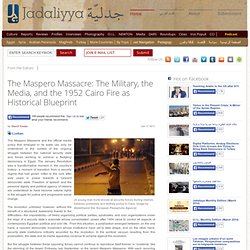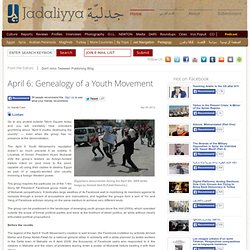

Why did Egyptians Revolt? Hazem Kandil on the Origins of the Egyptian Uprising - NABATAEANS : NABATAEANS.
Labour activism and the uprising. Debating the nature of the uprising - revolution or coup? Revolution and counter-revolution. Dealing with Dissent: the state post-uprising. Analysis - the Uprisings one year on. Anniversary in the city. Wednesday was the anniversary of Egypt’s January 25th uprising. Today is the anniversary of the Day of Rage, January 28th, when the people beat back the police and state security forces who had for so long cracked down on dissent and gathering in Cairo’s streets. The continued ability of Egyptians to mass mobilize, and to transform urban space into expressions of popular will and determination, is remarkable. This is my favorite photo from the revolution’s first anniversary: Larbi Sadiki’s recent op-ed on al-Jazeera English on “January 25th and the republic of Tahrir,” captures the centrality of space and urban control in Egypt’s uprising and ongoing revolution.
And images like the one above demonstrate the persistence of public gatherings and of an altered urban environment in Egypt. Agency was displayed in multiple colours, prayers, words, shapes, cries, songs, dances and slogans. Like this: Like Loading...
The fall of Mubarak... The Egyptian Uprising: Resources. The Maspero Massacre: The Military, the Media, and the 1952 Cairo Fire as Historical Blueprint. The Maspero Massacre and the official media policy that emerged in its wake can only be understood in the context of the ongoing struggle between the national security state and forces working to achieve a fledgling democracy in Egypt.

The January Revolution was a transformative moment in the country’s history: a moment of transition from a security regime that had grown rotten to the core after sixty years in power towards a nascent democratic state. Freedom of speech and the personal dignity and political agency of citizens are understood to have become natural rights in the struggle for justice and progressive social change. The revolution unfolded, however, without the benefit of a structured leadership thanks to the difficulties—the impossibility—of freely organizing political parties, syndicates, and civic organizations under the reign of a security state’s autocrats whose consolidated power after 1954 came to control all aspects of contemporary Egyptian political and civic life. April 6: Genealogy of a Youth Movement. Go to any protest outside Tahrir Square today and you will inevitably hear onlookers grumbling about “April 6 youths destroying the country” — even when the group has no presence at the demonstration.

The April 6 Youth Movement’s reputation doesn’t so much precede it as outstrip it. Loyalists of former President Hosni Mubarak vilify the group’s leaders as foreign-funded traitors intent on (and more to the point, capable of) using their cadres to destroy Egypt as part of a vaguely-worded plot usually involving a foreign Western power. The group inspires the particular ire of the “I Am Sorry, Mr President” Facebook group made up of Mubarak sympathizers. It dedicates large swathes of its Facebook wall to mobilizing its members against its nemesis through a torrent of accusations and insinuations, and together the groups form a sort of Yin and Yang of Facebook activism relying on the same medium to achieve very different ends.
The Seven Wonders of the Revolution. Around the corner from Tahrir Square, the heart of Egypt’s eighteen-day uprising, Mohamed Mahmud Street bears the scars of a turbulent political year in Egypt.

The once-bustling street off of Tahrir Square has seen its share of violent battlefields--beginning with 28 January 2011 and ending with the February 2012 clashes following the Port Said massacre. The pavements that once carried students from the American University of Cairo (AUC), Lycee Francais and Deutsche Schule Der Borromaerinnen have witnessed dying protesters dragged to cover, and defenseless men and women shot in the eye or collapsing from tear gas asphyxiation—all at the hands of the Egyptian security forces.
Mohamed Mahmud Street has come to feel like the graveyard of the revolution, or, as Mona Abaza calls it, an “emerging memorial space”, where so many brave Egyptians have died over the past year.